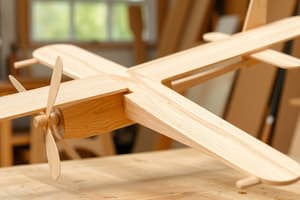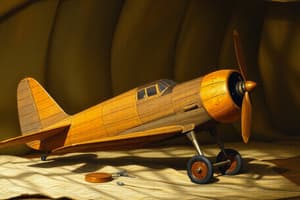Podcast
Questions and Answers
Which material was primarily used in aircraft construction during World War I?
Which material was primarily used in aircraft construction during World War I?
- Metal frames
- Wood (correct)
- Fiberglass
- Composite materials
What range of moisture percentage is considered ideal for aircraft wood structures?
What range of moisture percentage is considered ideal for aircraft wood structures?
- 5-10%
- 8-12% (correct)
- 15-20%
- 10-15%
What is the primary function of a borescope in the inspection of aircraft?
What is the primary function of a borescope in the inspection of aircraft?
- To assist in visual inspection of narrow, difficult-to-reach cavities (correct)
- To check the fuel systems
- To assess the exterior surface of the aircraft
- To measure the skin temperature of the aircraft
What should be considered when inspecting wood structures in aircraft?
What should be considered when inspecting wood structures in aircraft?
What factor contributes to the common deterioration of glue in aircraft wood structures?
What factor contributes to the common deterioration of glue in aircraft wood structures?
Which of the following surfaces needs to be prepared for proper gluing in aircraft construction?
Which of the following surfaces needs to be prepared for proper gluing in aircraft construction?
What happens to darker colored aircraft structures due to their color?
What happens to darker colored aircraft structures due to their color?
How can one check glued joints during an inspection?
How can one check glued joints during an inspection?
Flashcards are hidden until you start studying
Study Notes
Aircraft Construction Materials
- Wood was among the first materials used to build aircraft.
- Most World War I aircraft were not constructed of metal frames; wood was predominant.
- Wood remained the preferred material for aircraft construction until the 1930s due to a lack of suitable corrosion-resistant materials.
Wood Structure Inspection
- Inspection should occur in a dry, well-ventilated hangar, not in wet or poorly ventilated conditions.
- Proper inspection practices are essential for maintaining the integrity of wood structures.
Borescope Usage
- A borescope is an optical tool designed for visual inspection of narrow, hard-to-reach cavities.
- It aids in identifying potential issues within wood structures.
Moisture Content in Wood
- The ideal moisture range for wood in aircraft structures is 8-12%, not 15-20%.
- Maintaining the proper moisture level is crucial for durability and strength.
Adhesive and Joint Integrity
- Glue can deteriorate over time due to aging, extreme temperatures, and mechanical forces.
- Darker-colored aircraft accumulate higher skin temperatures and increased heat buildup.
- Glued joints are not typically designed to bear compression loads and may fail under excessive mechanical loads or accidents.
- For effective bonding, adhesive should be applied to both surfaces, contrary to a common misconception.
Wood Types and Adhesive Requirements
- Common wood types used in aircraft construction include solid wood, high-density plywood, and laminated wood.
- Surfaces must be clean, dry, and free from contaminants like grease, oil, wax, and paint for proper adhesion.
Inspection Techniques
- Tapping the subject area with a light plastic hammer helps differentiate between solid and hollow sounds, indicating potential issues in the structure.
- Various factors contribute to glue deterioration, such as chemical reactions from aging, mechanical stresses due to wood shrinkage, and fungal growths.
Studying That Suits You
Use AI to generate personalized quizzes and flashcards to suit your learning preferences.




